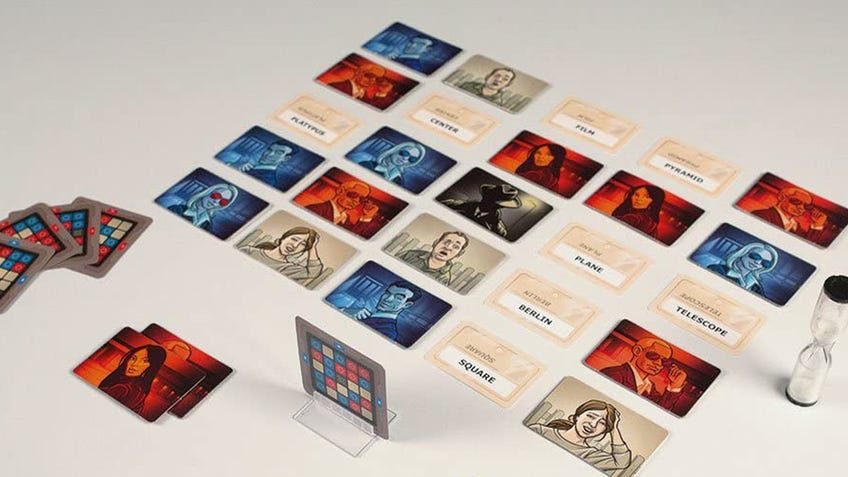How to play Codenames: board game’s rules, setup and scoring
In Codenames you’ll find all the tension and fun a world full of spies can offer.
Do you enjoy playing with words and enjoy watching tons of spy movies? Then you should play the word-wrangling board game Codenames!
In a hidden world of espionage, spies must be smart and sharp to survive and complete their missions. Codenames takes this premise and turns it into a game wherein players become spies who must communicate using codes while they try to find allied agents on the field.
How to play Codenames
- Player count, game length and overview
- How to set up Codenames
- Codenames rules
- Final Scoring and ending the game
During the game, players will have to deal with all the threats a real spy may encounter - such enemy spies, innocent civilians and dangerous assassins. In order to keep spies’ location a secret, players need to use clues to communicate with one another. The success or failure of a mission depends on how good you are at creating clues and interpreting them.
In this article, you can find all the basic rules you need to play Codenames. Though there are specific rules for the words spymasters can use, what makes a word valid or not and so on - it’s indicated by the game’s official rulebook itself that players should experiment and adapt the rules for valid clues for their groups.
Player count, game length and overview
Codenames is a word game wherein two teams of players compete against each other, trying to outsmart the other. In this game, players must be sharp to create and interpret clues about the codenames of agents on the field represented in cards. It’s intended for four to six players and it’s also a quick game to set up. Each session of Codenames might take from 15 to 30 minutes.
How to set up Codenames
To begin playing Codenames, players must organise two groups: the red one and the blue one. Each group must have at least one spymaster and one field operative agent. While the former is the player who gives the clues, the latter is responsible for trying to guess which card/s the clue is in reference to. In case there are a number of players higher or lower than four, you can choose to adapt the rules and have more than one spymaster per group or a single field operative agent for both groups. Regardless of how many players you have, it’s crucial that the spymasters of both groups sit on the same side of the table, facing their respective field operative agents. This positioning is important since field operatives are not allowed to access the same information spymasters are.
- Once everyone’s role is set, it’s time to prepare the table with the codename cards, agent cards and the key card.
- From the deck of 200 codenames, you must randomly pick 25 and place them in a 5-by-5 grid.
- Draw one card from the key card deck and place it in the stand in whatever orientation you want but facing the spymasters. Field operative agents can’t look at this card!
- Place the blue agent deck and the red agent deck in front of their respective spymasters. The double agent - a special card with both colours on it - is going to be placed on the top of the deck of the group that is starting the game.
- The bystander cards and the assassin card must also be kept close.
- Spymasters are the only ones that can look at the key cards because these show which of the codenames in the grid are related to the agents of their group. In each key card, there are blue and red squares, representing the position of blue and red agents. There are also pale squares, which are innocent bystanders and one black square for the assassin.
With that, you’re ready to start playing Codenames.

Codenames rules
In a session of Codenames, each team has one turn that can be split into two phases: the clue phase and the guessing phase.
To decide who is starting and consequently, who has the double agent card, you must check the colour on the edges of the key card - which can be either blue or red.
Clue phase
The clue phase is only played by the spymaster, and their goal is to guide their field operative agents to contact the right secret agents by finding who they are among the 25 codenames in the grid. The spymaster must say a one-word clue and a number determining the total of agents that clue is related to. So, if the blue spymaster sees in their key card that the “scorpion” and “lion” codenames in the grid are blue agents, they could say “Horoscope, Two” to guide their players towards those cards.
There are some rules spymasters must follow when deciding the word they are using as a clue.
Clues must be based on the meaning of the codename(s) the spymaster wants the field operative agent to find, but they must not use any direct reference to the codename itself. So, you can't say “key” if you’re giving a clue for the codename “Turkey” since you would be using a word that is included within the codeword.
Spymasters can’t use the words on the codename cards as clues.
The number regarding the total of codenames related to that clue can’t be part of it.
Spymasters can use numbers as a clue as long as they are referring to the meaning of the word. For example, “seven” is a clue for “rainbow.”
If players can’t understand the word, the spymaster can spell out the clue.
While all these are the basic rules that determine what makes a clue valid or not, there are other ones in the official rulebook. At the same time, a method one spymaster can use to check if their clue is valid is asking the opposing spymaster. If they say it’s valid, then you're good! In case a rule is invalid, the group’s round ends and the opposing spymaster can place one of their agent cards over one of their words before starting their turn.
If the spymaster said their clue and it’s valid, it’s time for the other player of their group to play as the field operative agents during the guessing phase.
Guessing phase
During the guessing phase, the player/s sitting on the other side of the table must interpret the clue given to them and find the right codename(s). While field operative agents can discuss the clue, their choice is only official when they touch the card they think is related to the clue.
It’s good practice for Spymasters during this phase that they should keep a straight face and must avoid reacting to their player’s actions in any manner that might influence their choices.
Once a card is chosen by the field operative agent, there are four possible consequences:
If they touch a codename that belongs to their team, even if it was not the one the spymaster was thinking of initially, then the spymaster can cover the word with one agent card of theirs. After, they can make another guess based on the same clue. The number of guesses allowed is equal to the number said by the spymaster plus one.
If their pick is actually a codename of one of the other team agents, then the opposing spymaster can place one of their agent cards over that word and the current group’s turn ends.
If the card selected is actually of an innocent bystander, the spymaster must cover it with an innocent bystander card and their turn ends.
If the player chooses the codename of the assassin, the word is covered with the assassin card and that team loses the game.

Since the chances of ending their team’s turn or even losing the game by selecting the assassin are high in Codenames, players might want to spend some time thinking before choosing a card. But if the group thinks they are taking too long, they can set a timer or use a sand timer to incentivise them to think a little bit faster.
In case the player doesn’t touch the assassin card and their turn ends either by finishing all guesses or touching an opposing team card or an innocent bystander, it’s time for the other group to play. One group’s turn begins once the guessing phase of the previous team ends.
Final scoring and ending the game
There are two ways a game of Codenames can end. First, one of the players playing as a field operative agent touches the assassin card. The other is when one of the groups places all of their agent cards over the codenames that belong to them. The first to do so wins the game and if they want to play more, they just need to change the codename cards and the key card.





